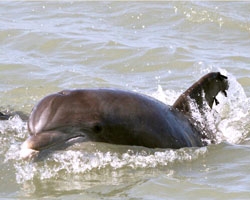http://www.emagazine.com/daily-news/bp-spill-two-years-after/
April 15, 2012 | Sharon Kelly |
A wide range of species, from dolphins to coral, are still dealing with the long-term results of the spill, which unleashed nearly 5 million barrels of oil into the Gulf.
© U.S. Fish & Wldlife Service
This week will mark the second anniversary of the explosion at BP’s Deepwater Horizon drilling platform, which led to the largest oil spill in US history. In the immediate aftermath of the spill, researchers marvelled at the ability of bacteria to consume the oil and natural gas that stretched across the gulf in a 22 mile-long plume. But a string of new studies show that the spill’s effects are far more persistent in the ecosystem than was initially hoped. In fact, a wide range of species, from dolphins to coral, are still dealing with the long-term results of the spill, which unleashed nearly 5 million barrels of oil and a still-unknown amount of natural gas into the Gulf. Results from many government and BP-funded studies are not yet public, as both sides are preparing for litigation over BP’s liabilities under the Clean Water Act and other environmental laws.
But a range of independent studies, along with those commissioned by the Gulf of Mexico Research Initiative, funded by BP after the spill and run by independent scientists, are beginning to emerge from peer review. While, on the surface, many areas of the Gulf seem relatively normal, researchers have found a wide range of impacts on animals and ecosystems that they say will continue for years or decades.
The oil and gas themselves have disappeared at an impressive speed, scientists say, especially compared to the Alaskan Exxon Valdez spill. Because the Gulf of Mexico is home to the highest number of natural underwater oil seeps in North America, large populations of bacteria that feed on hydrocarbons live in the region’s warm waters, and their population exploded in the aftermath of the spill.
But the story doesn’t end there, new research shows. These bacteria have caused many problems of their own.
These microbes are part of the food chain. When larger creatures consume the bacteria, some of the constituents of the oil and gas are passed along. Plankton, tiny organisms that form the base of the ocean’s food chain, have also been found to carry toxic polyaromatic hydrocarbons linked to BP oil, according to a February study published in Geophysical Research Letters, which found the problem extended all the way to the mouth of the Mississippi River.
Other bacteria, including some that are dangerous to people, have thrived in the tar balls formed by the spill. Tar balls on beaches in Mississippi and Alabama were laced with the potentially lethal Vibrio vulnificus bacteria, which can cause vomiting, diarrhea, abdominal pain and dermatitis, at levels 100 times greater than in seawater, according to a study published in the journal EcoHealth.
The upsurge in oil-devouring bacteria populations also caused problems. A thick mix of oil droplets and the remains from microorganisms that ate the oil, then died, rained down on the seafloor around the well, scientists say. Much of the coral in a seven mile range around the Macondo site is sick or already dead. Reefs further away from the well appeared relatively unharmed, researchers from Penn State University found. The scum found on some of them can be tied to the Macondo oil, according to a study published in the Proceedings of the National Academy of Sciences in March.
Closer to the surface, even animals at the top of the food chain have been affected. Since the spill, more than 520 dolphins have been discovered stranded in oil spill areas – but only roughly 25 were found alive and those animals had a poor prognosis, according to a newly released study from the National Wildlife Federation . Other researchers are studying whether the dolphin problems began after the dolphins swam through oil or breathed in fumes, which made them sick.
The Gulf of Mexico is also home to five species of sea turtles, four of which are endangered. Roughly half of the 1,149 sea turtles found stranded in the year after the spill were dead or dying. The vast majority, 481 of the 609 dead turtles were Kemp’s ridley sea turtles, the world’s most endangered sea turtle, according to the National Wildlife report.
“It will be critical to monitor these key species in the months and years ahead, especially given the unknown impacts of weathered and ‘dispersed’ oil remaining in the Gulf,” said Dr. George Crozier, retired director of Dauphin Island Sea Lab in a statement. “This disaster hit an ecosystem already weakened by years of wetlands degradation, including coastal areas around the Mississippi River Delta losing a football field worth of land every hour.”
For locals, the impact has been obvious. Louisiana fishermen describe dead zones that have failed to bounce back, in areas that were home to large populations of birds, fish, turtles and shellfish before the spill.
None of this has slowed the pace of drilling in the Gulf. The Obama administration has accelerated permitting for drilling in the region. Republican presidential candidates continue to pound the drum for even more drilling in the region.
Drilling industry officials say they are expecting at least 8 more rigs are headed to the Gulf for major projects there. That means the Gulf’s count of active drilling sites will soon be around 29, which is around the level that was occurring when the spill happened. It remains to be seen whether any of this new drilling will be safer than what was happening when the DeepWater Horizon blew up.
Special thanks to Richard Charter
